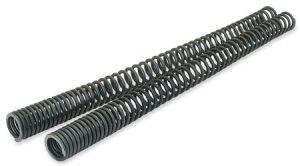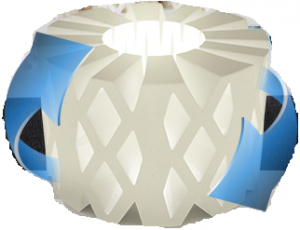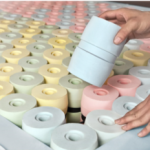
If anyone of us knows what progressive rate springs (PRS) are, the first place we expect them is in wheeled vehicles. In fact, that is the intended application of progressive rate coiled springs, and that is what comes up first in an online search. So it surprising to find “progressive rate springs” in the description of a mattress. And a waterbed mattress, no less!
Before we go on, let’s see what a progressive rate spring is. Some of us may already know, but not everyone.
A progressive rate spring is a spring with a rate of compression which increases as the spring is compressed. For instance, a normal spring has a linear rate. If it takes 20 pounds to compress it the first inch, it will take another 20 lbs. to compress it another inch, 20 lbs. more for the next inch, and so forth. So it takes 60 pounds to compress that spring 3 inches.
However, if this is a progressive rate spring, it takes more than 20 lbs. for the second inch, and even more for the third. As can be seen in the HyperCoils illustration above, the coil is wound tighter at one end that at the other. There are several PRS subcategories, but they apply the same principle.
Now how did that spring get into a mattress? The progressive rate springs in a few softside waterbed models by Sterling Sleep Systems are not exactly the same. They have the same property of a progressively increasing rate of compression, but they are not metal, and they are not coils. They are made of foam.


Progressive rate springs made of foam are not the first foam springs reviewed on Beds.org or covered on the Beds Blog, but they may be the oldest. The first ones covered were Octasprings featured by Dormeo. After that were the Dream Cells used by Reverie, the adjustable bed manufacturer, in its own mattresses. But the ones by Sterling were patented in 1990.
The Sterling Sleep Systems progressive rate springs are in intergral blocks. That means they are individual units that are part of one piece with the others. The concept is simple enough. Inverted cones or pyramids descend from a block of foam. The rate of taper and the densities in the foam control the rate of compression. The patent is broad enough that anyone else using the concept needs a license from Sterling.
How are these springs used in a waterbed? The PRS blocks are placed in the bottom of the water bladder with the points down. A row of blocks runs along each edge, and a row crosses the mattress in the middle. The ones along the edge are for edge support, and those in the middle are for lumbar support. Because the rate of compression is progressive, this system automatically adjusts to the body weight of the sleeper.
As we discover other types of foam springs and their applications, we will report on them.
This entry was posted on Thursday, May 19th, 2016 at 9:16 PM and is filed under beds, coils, flotation, foam springs, materials, mattresses, Progressive rate, springs . You can follow any responses to this entry through the RSS 2.0 feed. You can leave a response, or trackback from your own site.

Get New Post Notification via Email:
